NCERT Solution for Class 6 Science Chapter 4 - Exploring Magnets
Have you ever observed how the door of a refrigerator sticks when it is closed? This is due to magnets, and this real-life example brings in the idea presented in the NCERT Solutions for Class 6 Science Chapter 4 - Exploring Magnets. Through this chapter, the students learn to find out how the first magnets were discovered, what magnetic poles are, and the way they interact with each other, repelling or attracting. It also describes the distinction between the magnetic and non-magnetic materials using fun and simple activities.
This Story also Contains
- Download Class 6 Science Chapter 4 - Exploring Magnets Question Answers PDF
- NCERT Solutions for Class 6 Science Chapter 4 - Exploring Magnets: Exercise Question and Answer
- Approach to Solve Questions of Class 6 Science Chapter 4 - Exploring Magnets
- Class 6 Science Chapter 4 Exploring Magnets - Topics
- Benefits of NCERT Solutions for Class 6 Science Chapter 4 - Exploring Magnets
- NCERT Solutions for Class 6 Science Chapter Wise
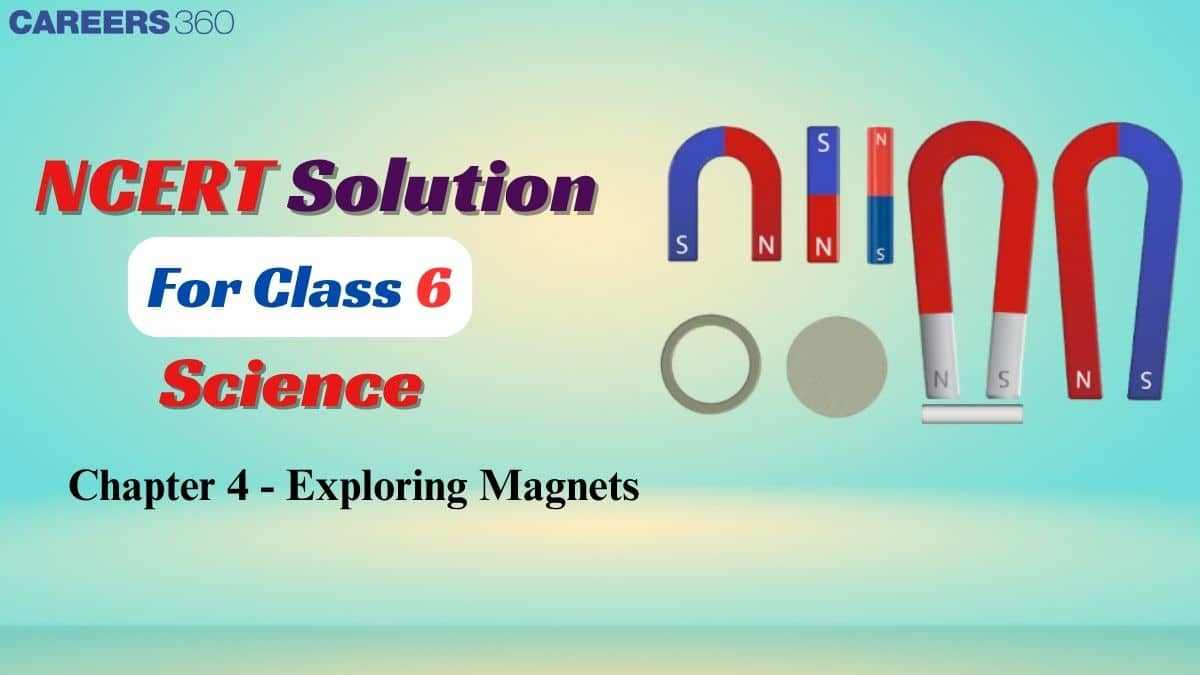
The solutions are composed in simple and understandable language, and learning is therefore easy and efficient. The NCERT Solutions for Class 6 Science Chapter 4 - Exploring Magnets give step-by-step answers and clearly labelled diagrams, which help students to have a clear idea concerning such concepts as poles, attraction and repulsion. These NCERT solutions are best practised on a regular basis to enhance conceptual clarity, confidence, and readiness to take exams. These Class 6 Science Chapter 4 - Exploring Magnets question answers can be revised at all times to eliminate doubts and teach learners how they can use magnetism in their daily life scenarios. To extend their information and problem-solving skills, students may also visit NCERT Solutions Class 6 for other chapters.
Download Class 6 Science Chapter 4 - Exploring Magnets Question Answers PDF
Class 6 Science Chapter 4 - Exploring Magnets Solutions in PDF format enables students to study in their convenience and flexibility as they can study it anytime on a mobile phone, tablet or computer even when he/she is not connected to the internet. With the PDF of the Exploring Magnets NCERT Solutions, it is much easier to revise such important concepts as magnetic poles, attraction, repulsion, and magnetic materials. These Exploring Magnets class 6 question answers are particularly useful in case of some urgent revisions or when just about to take an exam, as students will be fully aware of the chapter material and perform better in an exam.
NCERT Solutions for Class 6 Science Chapter 4 - Exploring Magnets: Exercise Question and Answer
The NCERT Solutions for Class 6 Science Chapter 4 - Exploring Magnets help students to get the answers to all the questions of the textbook and every point of the exercises of the textbook in a step-by-step manner. Such solutions make students learn about significant concepts like magnetic poles, attraction and repulsion, and applications of magnets in everyday life. Written according to the most recent NCERT curriculum, the Class 6 Science Chapter 4 - Exploring Magnets question answers PDF is an ideal source of exam preparation, fast revision and development of a high-quality conceptual understanding.
Question 1.1: Fill in the blanks.
Unlike poles of two magnets ………… each other, whereas like poles ............ each other.
Answer: Attract
Unlike poles attract each other, and like poles repel each other.
Question 1.2: Fill in the blanks
The materials that are attracted towards a magnet are called ……….
Answer: Magnetic materials
Question 1.3: Fill in the blanks
The needle of a magnetic compass rests along the ……….. direction.
Answer: North-South Direction
Question 1.4: Fill in the blanks
A magnet always has ………. Poles.
Answer: Two
Question 2.1: State whether the following statements are True (T) or False (F).
A magnet can be broken into pieces to obtain a single pole. [ ]
Answer: False
Question 2.2: State whether the following statements are True (T) or False (F).
Similar poles of a magnet repel each other. [ ]
Answer: False
Question 2.3: State whether the following statements are True (T) or False (F).
Iron filings mostly stick in the middle of a bar magnet when it is brought near them.[ ]
Answer: false
Question 2.4: State whether the following statements are True (T) or False (F).
A freely suspended bar magnet always aligns with the north-south direction.[ ]
Answer: True
Question 3: Column I shows different positions in which one pole of a magnet is placed near that of the other. Column II indicates the resulting interaction between them for different situations. Fill in the blanks.
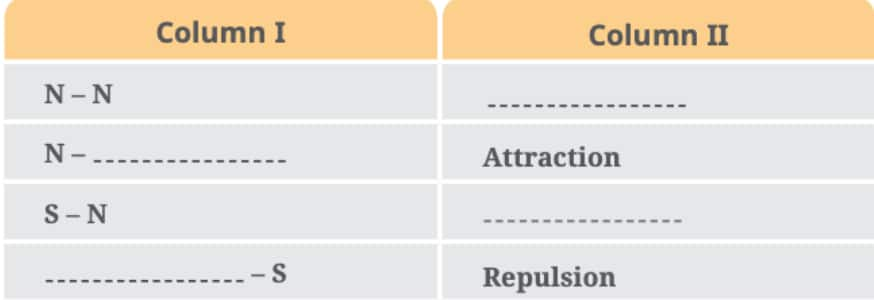
Answer:
|
Column I |
Column II |
|
N - N |
Repulsion |
|
N - S |
Attraction |
|
S - N |
Attraction |
|
S - S |
Repulsion |
Question 4: Atharv performed an experiment in which he took a bar magnet and rolled it over a heap of steel U-clips (Fig. 4.15). According to you, which of the options given in Table 4.3 is likely to be his observation?

Table: Number of pins attracted by the magnet at its various positions
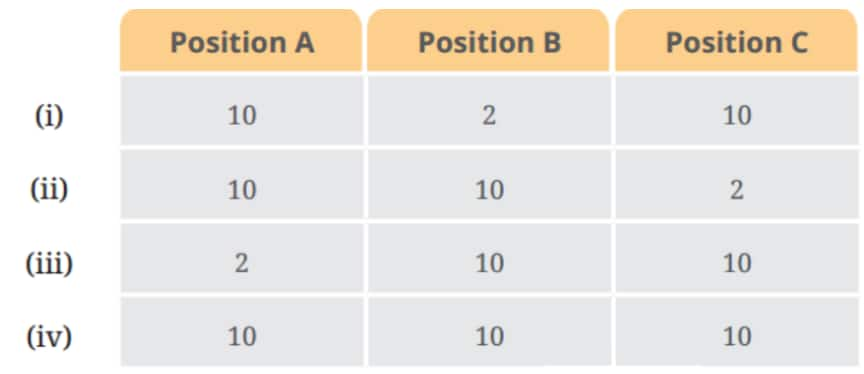
Answer: From the figure, it is clear that the ends of the magnet have more iron fillings attached to them. This is because the magnet's strength lies more at the ends of the magnet. Hence, option(i) is correct.
Question 5: Reshma bought three identical metal bars from the market. Out of these bars, two were magnets and one was just a piece of iron. How will she identify which two amongst the three could be magnets (without using any other material)?
Answer: Reshma can identify the magnets through the principle of repulsion. Magnets repel other magnets when like poles are brought close. The iron bar will only be attracted but won't show repulsion, helping her identify the magnets.
Question 6: You are given a magnet which does not have the poles marked. How can you find its poles with the help of another magnet which has its poles marked?
Answer: By bringing the marked magnet near the unmarked one, if the two ends attract, the unmarked magnet's pole is the opposite of the marked magnet's pole. If they repel, the poles are similar.
Question 7: A bar magnet has no markings to indicate its poles. How would you find out near which end its North pole is located without using another magnet?
Answer: Suspend the magnet freely, and it will align itself in the north-south direction. The end pointing towards the north is the North Pole, and the end pointing towards the south is the South Pole.
Question 8: If the earth is itself a magnet, can you guess the poles of the earth’s magnet by looking at the direction of the magnetic compass?
Answer:
Yes, we can guess the poles of Earth’s magnet by looking at the direction of the magnetic compass. The north-seeking end of the compass needle points towards the geographic North Pole of the Earth.
Question 9: While a mechanic was repairing a gadget using a screw driver, the steel screws kept falling down. Suggest a way to solve the problem of the mechanic on the basis of what you have learnt in this chapter.
Answer: The mechanic can magnetise the screwdriver by rubbing a magnet along its length several times. This will allow the screwdriver to hold the screws securely while working.
Question 10: Two ring magnets X and Y are arranged as shown in Fig. 4.16. It is observed that magnet X does not move down further. What could be the possible reason? Suggest a way to bring magnet X in contact with magnet Y, without pushing either of the magnets.
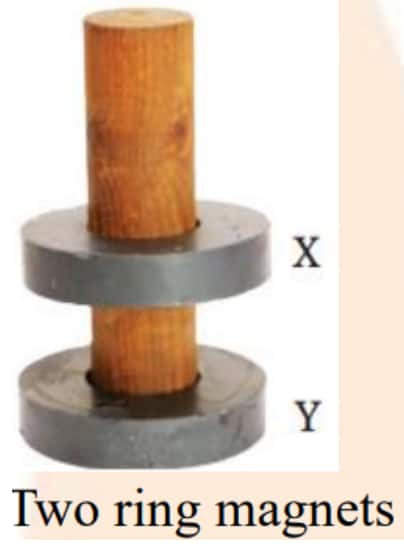
Answer: Magnet X must be floating because the like poles are facing each other (like poles repel each other). If we change the direction of the magnet X by rotating it, the opposite poles will face each other, and the magnets will come closer. Magnet X is likely repelling Magnet Y because their like poles are facing each other. By rotating magnet X so that opposite poles face each other, the magnets will attract and move closer.
Question 11: Three magnets are arranged on a table in the form of the shape shown in Fig. 4.17. What is the polarity, N or S, at the ends 1, 2, 3, 4 and 6 of the magnets? Polarity of one end (5) is given for you.
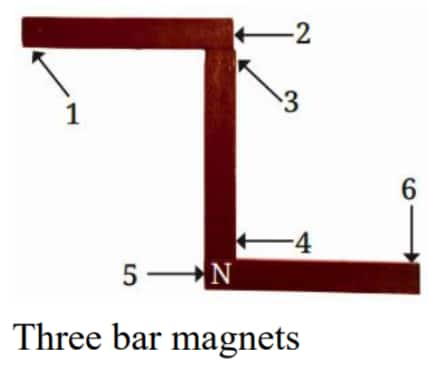
Answer:
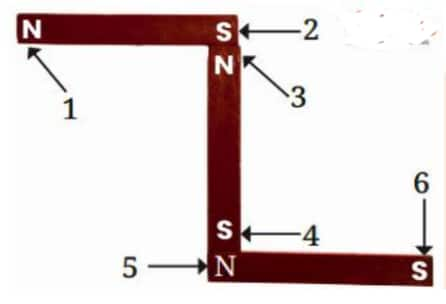
|
Point |
Polarity |
|
1 |
N |
|
2 |
S |
|
3 |
N |
|
4 |
S |
|
6 |
S |
Approach to Solve Questions of Class 6 Science Chapter 4 - Exploring Magnets
The chapter Class 6 Science Chapter 4 - Exploring Magnets presents the students with the fundamentals of magnets, their characteristics, and their real-life use. In order to answer the questions in this chapter well, the students will be required to learn and not memorize the major concepts. The method to be adopted is as follows:
- Read and Understand the Chapter: Read the chapter thoroughly to get to know about the properties of magnets, the discovery of magnets and how they interact with objects.
- Identify Key Properties: Pay attention to concepts such as attraction and repulsion, magnetic poles, and the fact that magnets always contain two poles.
- Differentiate Objects: Practice relating items into magnetic (similar to iron, nickel, cobalt) and non-magnetic (similar to plastic, wood, glass).
- Observe Real-Life Examples: To strengthen your answers, consider how people use magnets in their everyday life, such as in compasses, refrigerators, speakers, and toys.
- Revise Important Terms: Learn terms such as magnetic poles, induced magnetism, magnetic field and lodestone so that you can write the correct answers.
- Practice Question-Answer Solutions: Study Exploring Magnets NCERT Solutions to get an idea, how one should frame answers in simple and clear language.
- Use Diagrams Where Needed: To make your answers more effective, have a practice at drawing neat diagrams (such as depicting poles of a magnet or a compass needle).
Class 6 Science Chapter 4 Exploring Magnets - Topics
NCERT Class 6 Science Chapter 4 Exploring Magnets presents students to the wonderful world of magnets, their discovery, and applications in daily life. The chapter includes such significant issues as the history of magnets, the characteristics of the magnetic materials, magnetic and non-magnetic materials and the phenomenon of magnetic poles. Through the learning of these concepts, students develop a solid background in science and learn the important role of magnets in technology and everyday life.
- Magnetic and Non-magnetic Materials
- Poles of Magnet
- Finding Directions
- Attraction and Repulsion between Magnets
- Fun with Magnets
Benefits of NCERT Solutions for Class 6 Science Chapter 4 - Exploring Magnets
The Class 6 Science Chapter 4 - Exploring Magnets question answers give the students a clear and systematic method of knowing the fundamentals of magnetism. These Exploring Magnets NCERT Solutions present major concepts such as the magnetic poles, attraction, repulsion, and usage of the compass in a very straightforward way. They assist in preparation of exams, doing homework and in practical use of science concepts in actual life.
-
Clear and elaborate explanations of the concepts of magnetism to enhance understanding.
-
Discusses fundamental concepts such as magnetic poles, attraction and repulsion, and how a compass works.
-
Step-by-step answers to textbook questions and previous exam-style problems.
-
Incorporates real-life activities and experiments to relate theory and practice.
-
Helps students use magnetism to solve common problems related to science.
-
Written in simple language to enable easy understanding of difficult concepts.
-
Promotes independent learning and self-study using organized solutions.
-
Helps to revise quickly before exams and in doing assignments.
-
Incorporates practical demonstrations of magnets for the students, and makes them memorable.
-
Develops trust in Science through frequent practising and concept reinforcement.
NCERT Solutions for Class 6 Science Chapter Wise
The NCERT Solutions to Class 6 Science give answers to all the chapters in the recent NCERT textbook in detail, step-by-step. All these solutions enable students to develop sound fundamentals, be well prepared in exams, and learn concepts easily. It is easy to revise and/or access any topic in a matter of seconds through chapter-wise links.
NCERT Solutions for Class 6 - Subject-Wise Links
Also Check NCERT Books and NCERT Syllabus here
Frequently Asked Questions (FAQs)
A magnet is a substance that pulls iron, nickel, or cobalt objects. It possesses two poles- north and south pole, and exhibits the repulsion and attraction property.
On a magnetic compass, there is always a little magnetic needle, which points north-south. The reason why it works is that the needle is aligned with the magnetic field of the earth, and it assists us in directions.
The ancient Greeks conducted the first experiments on magnets in a city called Magnesia. Magnets were subsequently studied by a scientist William Gilbert in 16 th century.
Like poles of magnets repel each other, while unlike poles attract. For example, North-North repels, but North-South attracts.
A freely suspended magnet always points in the North-South direction. This property is used in magnetic compasses to find directions.
Popular Questions
Courses After 12th
Applications for Admissions are open.
This ebook serves as a valuable study guide for NEET 2025 exam.
NEET Previous 10 Year Questions
Get nowThis e-book offers NEET PYQ and serves as an indispensable NEET study material.
JEE Main Important Physics formulas
Get nowAs per latest syllabus. Physics formulas, equations, & laws of class 11 & 12th chapters
JEE Main Important Chemistry formulas
Get nowAs per latest syllabus. Chemistry formulas, equations, & laws of class 11 & 12th chapters
JEE Main high scoring chapters and topics
Get nowAs per latest 2024 syllabus. Study 40% syllabus and score upto 100% marks in JEE
JEE Main Important Mathematics Formulas
Get nowAs per latest syllabus. Maths formulas, equations, & theorems of class 11 & 12th chapters
